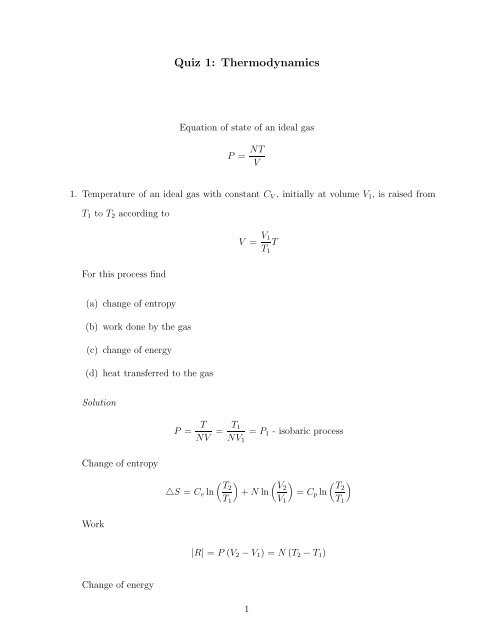You also want an ePaper? Increase the reach of your titles
YUMPU automatically turns print PDFs into web optimized ePapers that Google loves.
<strong>Quiz</strong> 1: <strong>Thermodynamics</strong>Equation of state of an ideal gasP = NTV1. Temperature of an ideal gas with constant C V , initially at volume V 1 , is raised fromT 1 to T 2 according toFor this process findV = V 1T 1T(a) change of entropy(b) work done by the gas(c) change of energy(d) heat transferred to the gasSolutionChange of entropyWorkP = TNV = T 1NV 1= P 1 - isobaric process( ) ( ) ( )T2 V2 T2△S = C v ln + N ln = C p lnT 1 V 1 T 1|R| = P (V 2 − V 1 ) = N (T 2 − T 1 )Change of energy1
△E = C V (T 2 − T 1 )HeatQ = △W = C p (T 2 − T 1 )2. An ideal gas with constant C V undergoes the following cycle:• adiabatic expansion from (p 1 , V 1 ) to (p 2 , V 2 )• isobaric compression to (p 2 , V 1 )• isochoric (constant volume) return to initial state (p 1 , V 1 )Find the efficiency of the cycle.SolutionWork done in the cycle is in adiabatic and isobaric processes (negative)|R| = C V (T 1 − T 2 ) − p 2 (V 2 − V 1 )= C VN (p 1V 1 − p 2 V 2 ) − p 2 (V 2 − V 1 ) = 1γ − 1 (p 1V 1 − p 2 V 2 ) − p 2 (V 2 − V 1 )Heat received in the cycle is during the isochoric processQ = C V (T 1 − T 3 )Efficiencyη = |R|Q = C V (T 1 − T 2 ) − p 2 (V 2 − V 1 )C V (T 1 − T 3 )= (γ − 1)−1 (p 1 V 1 − p 2 V 2 ) − p 2 (V 2 − V 1 )(γ − 1) −1 (p 1 − p 2 )V 1= (p 1V 1 − p 2 V 2 ) − (γ − 1)p 2 (V 2 − V 1 )(p 1 − p 2 )V 1= (p 1 − p 2 ) V 1 − γp 2 (V 2 − V 1 )(p 1 − p 2 )V 1= 1 − γ V 2/V 1 − 1p 1 /p 2 − 12
3. A thermally insulated cylinder, closed at both ends, is fitted with a frictionless heatconductingpiston which divides the cylinder into two equal parts containing the sameamounts of an ideal gas with constant C V at temperatures T 1 and T 2 and pressures P 1and P 2 respectively. The piston is release and the system reaches equilibrium. Find(a) the final temperature and pressure(b) the change of entropy and show that it is ≥ 0SolutionSince the piston is heat conducting, T will be the same in both compartments. AlsoP will be the same. Consequently, volumes will be the same and equal.The change of entropy is2C V T = C V (T 1 + T 2 )T = T 1 + T 22P = NT(V/2) = P 1T (V/2)T 1 (V/2) = P 1T T 1 + T 2= P 1T 1 2T 1(also = P 2T 1 + T 22T 2since P 1T 1= P 2T 2=N(V/2)( ) ( ) ( ) ( T T T2 (T1 + T 2 ) 2 )△S = C V ln + C V ln = C V ln = C V ln≥ 0T 1 T 2 T 1 T 2 4T 1 T 2)3
















